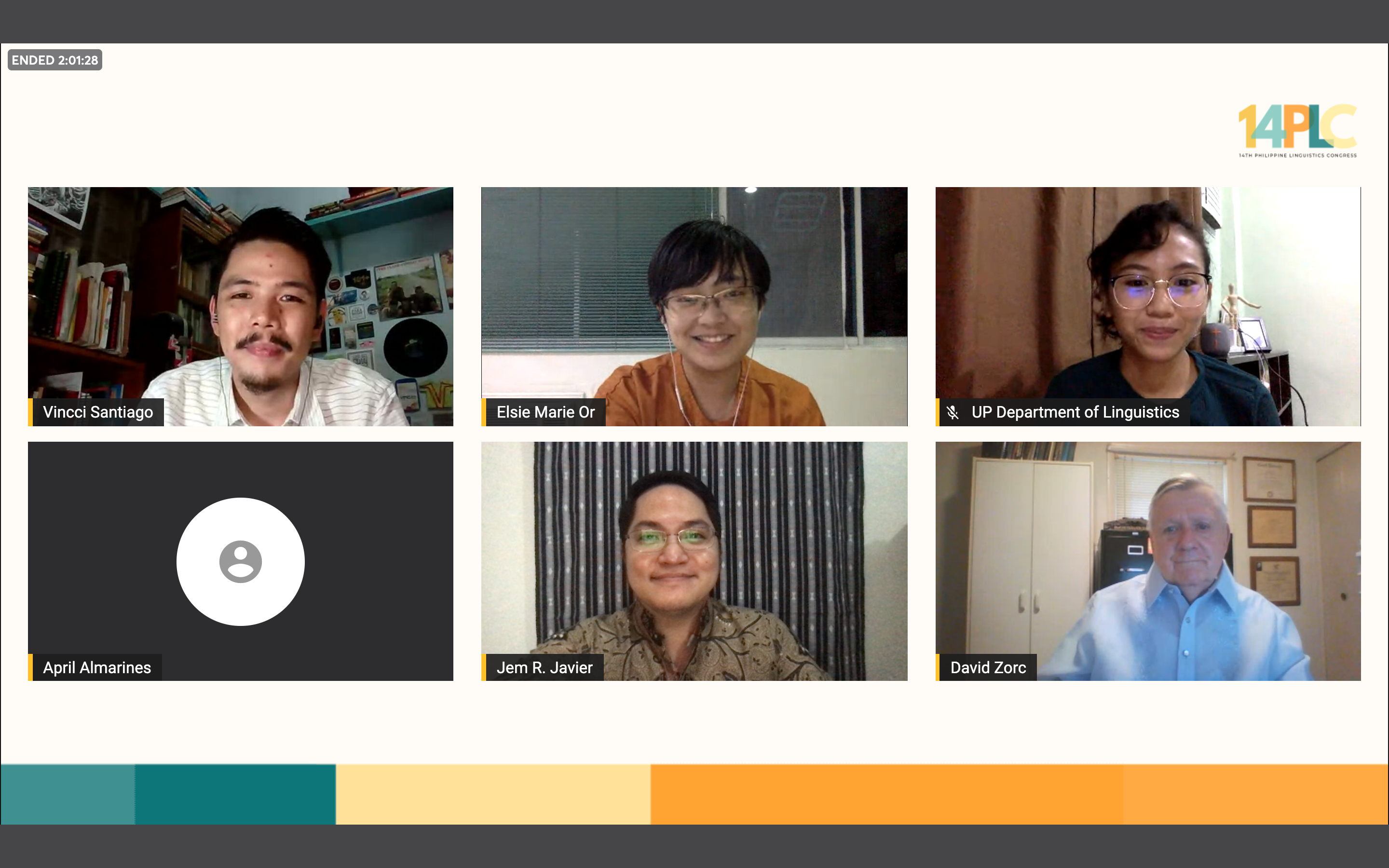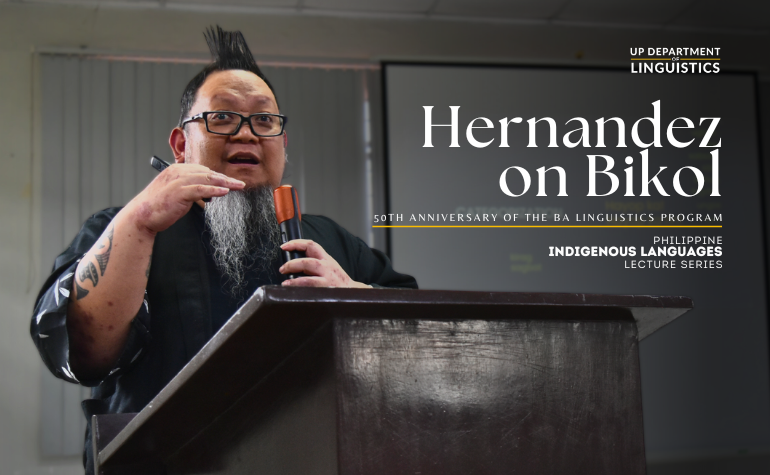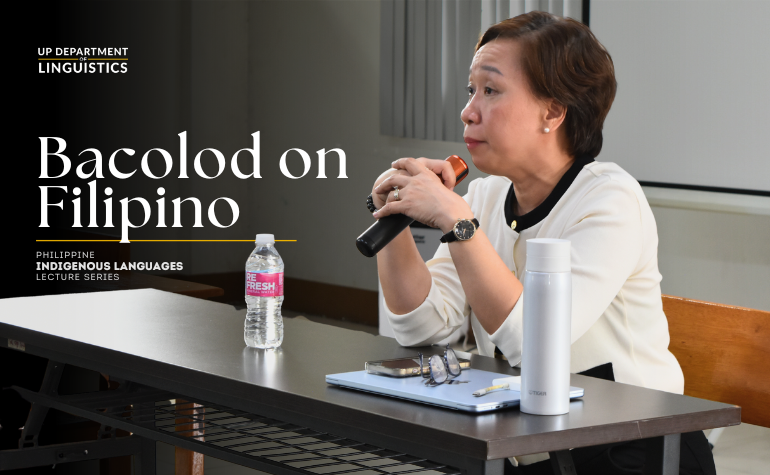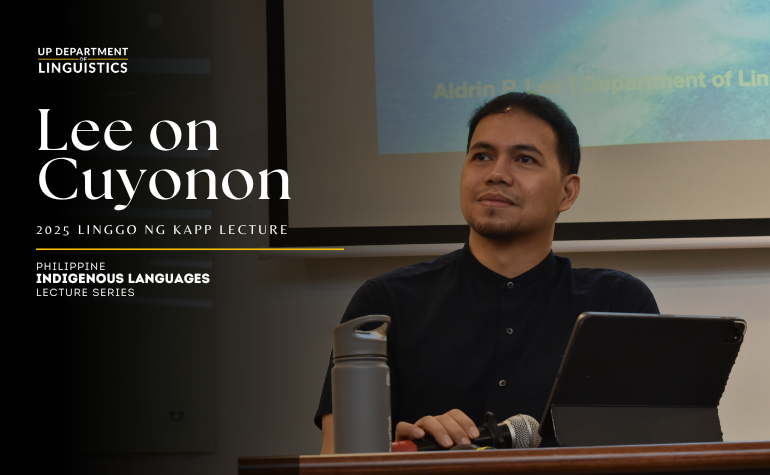
At the opening of the 14th Philippine Linguistics Congress on 24 August 2021, Dr. R. David Zorc delivered the plenary lecture where he presented his ongoing research on axis relationships among Philippine languages. This lecture was moderated by Instr. Vincent Christopher Santiago.
According to Zorc, while working on his PhD dissertation on Bisayan languages in 1972, he came across a number of innovations—phonological, morphological, syntactic, and semantic changes exclusively shared by a set of languages—that cut across two or more well-established subgroups. A notable example is the proto-form *bakál ‘to buy,’ which replaced the Proto-Austronesian (PAN) *bəlih in West Bisayan, Asi’, Central Bisayan, Bikol, and South Mangyan. Typically, innovations indicate subgroups—groups of languages more related than others within the same family. However, innovations appearing in more than two subgroups led Zorc to posit that these forms indicate relationships that developed from close trade and societal ties among speakers of these subgroups and these phenomena are beyond the scope of traditional subgrouping.
Axes and related terms defined
Axes are quite tricky to define, but they can be described as innovations found in more than two (well-established) subgroups. Most of these innovations occur in subgroups in geographic proximity, but some, in geographically distant subgroups. At this juncture, Zorc clarified that axes represent neither macrogroups nor selective innovations. First, a macrogroup is a higher-order subgroup with lower-order subgroups as its members. Good examples of macrogroups are Cordilleran and Greater Central Philippine (GCP). Second, a selective innovation is a type of innovation that replaces an established etymon in geographically distant subgroups. For instance, PPH *dagʔun ‘year,’ which replaced PMP *taqun, is found in Northern Cordilleran, Mangyan, West Bisayan, Danao, and Central Manobo languages.
15 axis relationships in the Philippines
In this lecture, Zorc discussed 15 axis relationships by the order in which he discovered them, while the accompanying examples are the most pervasive and persuasive. As explained below, a subgroup or its member/s (e.g., Tagalog and Ilokano) can generally be part of more than two axis relationships. Out of these relationships, only the *R>Y language axis is phonological, the rest are lexical.
- North Bisayan (NB) axis is the first to have been discovered. This axis includes West and Central Bisayan members, Asi’, Bikol, and Hanunuo, and Kagayanen. In this axis, NB-axis *bəʔə́l ‘to take, get something’ replaced PAN *alap in Kinaray-a, Pandan, Semirara, Kuyonon, Aklanon, Bulalakawnon, Datagnon, Asi’, Romblomanon, and Hanunuo, while *hambal ‘to speak’ replaced PAN *kaRi in Kinaray-a, Hiligaynon, Semirara, Kagayanen, Aklanon, and Romblomanon.
- The Southern Luzon (SLz) axis includes Tagalog, Sambalic and Kapampangan, Remontado, Casiguran Dumagat, Bulalakawnon, Bikol, and Hanunuo. SLz-axis *ʔalikabúk ‘dust’ replaced PMP *Rabuk, PWMP *qabug ~ *abuR in Kapampangan, Botolan, Ayta Mag-Indi, Casiguran Dumagat Agta, Tagalog, and Bulalakawnon.
- Eastern Mindanao (EMn) axis, proposed by Andrew Gallman as a subgroup called Proto-East Mindanao, includes South Bisayan, Mansakan, Danao, and Subanon languages, various Manobo members, and Mamanwa, most of which clearly moved west (except Subanen). In this axis, the most notable example is EMn-axis *dayáw ‘good’, which replaced PMP *ma|pia, PPH *ʔupiya in Kamayo, Boso, Tandaganon, Mansaka, Mamanwa, Kalagan, Tagakaolo, Caraga, Kabasagan, Mandaya, and Isamal.
- Northern Luzon (NLz) axis includes Cagayan Valley, Central Cordilleran, and Bashiic languages and Ilokano. NLz-axis *kímat ‘eyelashes’ replaced PWMP *qizəp, PPH~PSP *pidə́k in Itneg, Kiangan Ifugao, and Balagaw.
- Central Luzon (CLz) axis mainly consists of Central and South Cordilleran subgroups but extends south into Sambalic, Kapampangan, and Tagalog. CLz-axis *bəlát ‘skin’ replaced PMP *kulit in Kayapa Kallahan, Keley-I Kallahan, Ibaloy, Kapampangan, and Tagalog.
- Palawan-Kalamianic (Pal-Kal) axis involves Palawanic subgroup and Kalamianic languages. Pal-Kal-axis *bəlag ‘not so [NEG]’ replaced *bəkə́n in Agutaynen, Karamianen, Palawano, and Aborlan.
- Palawan-Mindoro (Pal-Mind) axis involves North Mangyan, South Mangyan, Kalamianic, and Palawanic. An example is Pal-Mind-axis *bílug ‘body’ that is found in Batak, Aborlan, and Palawano, Hanunuo, Buhid, Tadyawan, and Alangan.
- Southern Mindanao (SMn) axis include Southwestern (Blaan, Tëduray, and Tboli), more commonly known as Bilic, Southeastern (Bagobo-Klata), and GCP members such as Tagalog (back when it was still far south), Danao, and Manobo. Examples are SMn-axis *ŋalap ‘fish; game (meat which is caught)’ found in Blaan, Atta Manobo, Bagobo-Klata, and Ilianen Manobo and *samáʔ ‘bad, evil’ found in both Tagalog and Bagobo-Klata.
- Central Mindanao (CMn) axis involves GCP members in Mindanao such as Mansaka, Danao, Subanen, and Manobo. A good example is CMn-axis *balaw ‘story, talk, tell’, which is found in Boso, Caraga, Isamal, Mansaka, Dibabawon, and Sarangani Manobo.
- Bisayan-Bikol (Bis-Bik) axis includes some innovations shared by Bisayan and Bikol languages only. For instance, Bis-Bik-axis *kaláyuØ ‘fire’ replaced PAN *Sapuy. Bis-Bik-axis *hálnas ‘slippery’ is another excellent example.
- Catanduanes (Catanduanes) axis is the most recent phenomenon in the list. It includes Northern Catanduanes, an isolate, and Viracnon, a Northern Bikol member. Examples are Catanduanes-axis *tiŋú ‘tooth’ and *paribúd ‘go home’, which replaced PAN *ŋipən and PMP *uliq respectively.
- Western Luzon (WLz) axis covers Bashiic, Ilokano, Central and Southern Cordilleran, and Central Luzon languages. WLz-axis *bulúŋ ‘leaf’ replaced PMP *dahun in Ilokano, Ibaloy, Kayapa Kallahan, Pangasinan, Sambal, Bolinao, Botolan, Kapampangan, Itbayaten, and Ivatan.
- North-Central Luzon (NCLz) axis covers Cagayan Valley and Central Cordilleran languages. NCLz-axis *săkaláŋ ‘ring’ replaced *siŋsiŋ in Central Cagayan Agta, Atta Pamplona, Pamplona and Tuguegarao Ibanag, Kalinga, and Itawis.
- Bashiic-Ilokano (Bash-Ilk) axis includes innovations limited to Bashiic languages and Ilokano. For example, Bash-Ilk-axis *dúyuR ‘coconut-shell receptacle for food or water’ is found in all these languages.
- *R > Y language axis is also called “the North Extension,” which was proposed on the basis of the merger of PAN *R with *y, a phonological innovation not found elsewhere. This axis phenomenon contains North Mangyan, Batanic/Bashiic, and Central Luzon languages (i.e., Kapampangan and Sambalic). Two excellent lexical innovations are *R>Y-axis *bulkas ‘morning, tomorrow’ and *butʔul ‘bone; seed’, which replaced PAN *CuqəlaN, PMP *tuqəlan, PWMP *tuqəlaŋ. It is worth noting that there are forms in the members of South Mangyan, Palawanic, and Kalamianic subgroups reflecting *R as /y/ instead of /g/ in the first two and /l/ in the latter. These forms are purported to be evidence that an ancient member of this axis could have once been the prestige language within the area of these subgroups.
Open Forum
An open forum followed the lecture, with some of the questions summarized below.
The first one asked about the data presented by Blust (2019) to support the Proto-Philippine subgroup and whether the patterns are indicative of a linkage/axis rather than a single Philippine subgroup. Zorc answered that he is in agreement with Blust’s position except for two things: (1) inclusions from Casiguran Dumagat and (2) Bashiic-Ilokano axis forms. For the cited forms of Casiguran Dumagat, it has been heavily influenced by Tagalog and Bikol, so not all of them may be Proto-Philippine. Zorc also added that at least 800 of Blust’s etymologies are solid in that they would stand the test of time.
The second question has to do with the adequacy of using trees as representation of linguistic relationships and how realistic it is to propose a single tree for a group of languages given that there may be different ways on how languages develop and change. According to Zorc, in agreement with Blust, both the tree and wave models are essentially correct because the answer depends on the relationship of the languages one compares. For some languages that have nice, neat descendancies such as Aklanon and Kinaray-a, the tree model works for them. For others like Tausug and Sama languages, they are different nodes because Sama languages come from Borneo, while Tausug comes from Butuan. The wave model works for these languages.
The final question inquired about Dr. Zorc’s position in the formulist–realist dichotomy in historical linguistics when it comes to treating reconstructions. Zorc agrees with the realist side because Philippine languages are consistent phonologically and Austronesian reconstructions are mostly straightforward.
The study of Dr. Zorc looked further into the relationship between Philippine languages that go beyond subgrouping and in so doing, solidified the close relationships of the languages and the ethnic groups speaking them. There may also be axes that exist but are still undiscovered and can be a subject for future research and discoveries, not just for languages, but also for its implications, i.e. trade relations, population movement, societal ties, etc.
A recording of the talk can be viewed on our YouTube channel.

Published by Edward G. Estrera



